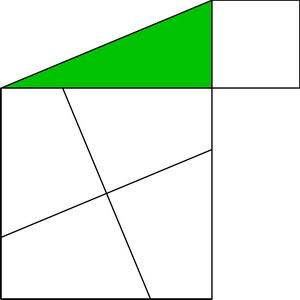
|
Pythagoras 1
Years 6 - 10
|

Preparation
- Print this sheet of puzzle pieces.
Printing on thin card would be marvellous, but if not, paper will do.
- Carefully cut out the puzzle pieces. Find an envelope or press-seal bag for storing them.
- Find a ruler and pencil. You will need them later in the activity.
- Print this square line paper.
- Write the title of this challenge and today's date on a fresh page in your maths journal.
Getting Started
- You need all the shapes except the triangle and the square.
Leave those two in the envelope.
- You are using four (4) congruent quadrilaterals.
What do you think quadrilateral means?
What do you think congruent means?
Answer in your journal.
- Put the four pieces together to make a square.
Its area will be 4 quadrilaterals.
Sketch how the pieces fit.
- Put the four pieces together to make a square with an empty space in the middle.
Sketch how the pieces fit.
Do you notice anything about the empty space?
The Next Challenge
Now you know you can make a four piece square and a five (5) piece square.
- Open this Pythagoras 1 Starter.
You can read it on screen or print it.
- Now you will include the triangle and square with the four quadrilaterals.
Read the Story and work through Questions 1, 2 & 3.
Don't do the challenge on the starter yet.
- Make notes and diagrams that connect with what you recorded before.
|

|
Have fun exploring Pythagoras 1

A mathematician named Henry Perigal discovered how to cut the middle size square into four quadrilaterals and use them to demonstrate Pythagoras' Theorem. He wasn't a professional mathematician like a university professor or a computer programmer. Mathematics was his hobby. He did it in his spare time because he liked the challenges. But he is famous because of his discovery.
In Questions 1, 2 & 3 you used the Perigal Pieces to prove Pythagoras' Theorem for one triangle. You showed that the four piece square together with the small square piece have the same area as the square built on the hypotenuse of a right angle triangle.
- But proving Pythagoras works for one triangle doesn't prove it works for all triangles.
- It might work just for that one. We have to try at least one more.
- Return to the Challenge on the Starter.
- It asks you to create your own triangle and its squares.
- Use them to do Questions 1, 2 & 3 again.
You will need to discover how Henry Perigal knew where to draw
the cut lines to make the four pieces of the middle size square.
Hints
- As suggested on the Starter, use your pieces as a model.
- Anything special about where the cut lines cross?
- Can you find another special shape in the drawing?
Now you have proved Pythagoras works for two triangles.
But what happens if the triangle is isosceles?
Then the two squares would be the same size.
Would they combine to make the square on the hypotenuse?
Investigate.
|
 |

You have checked Perigal's Proof of Pythagoras' Theorem for three different triangles. It took a lot of time and it still doesn't prove that it works for every right angle triangle. Perigal proved it for every right angle triangle. That's something we don't need to do right now, but at least we know he didn't do it one triangle at a time. So there is still more to learn.
A mathematician would also have to check what happens if the triangle doesn't have a right angle.
Playing with Perigal
We know the four quadrilaterals can make the four square or the five square with a space in the centre. In these puzzles you will learn to make them using rotation. However it is better if your quadrilaterals have some thickness to hold onto. Glue them to a piece of card and cut around them carefully.
Turning a square into a square
In this puzzle it's like working with a Transformer toy.
- Make the five piece with the space in the middle.
- It is possible to use rotation only to transform the five piece with the gap into the four piece.
Investigate.
Hint:
To rotate you need a centre of rotation - a point to pin it while it is turned.
But the centre of rotation doesn't have to be the centre of the object. It can be anywhere.
When you figure it out, practise it until you can do it smoothly. It feels really good to do.
Turning a stack into a square
This time you use rotation and sliding (also called translating).
- Stack up the four pieces so the edges all match.
- Leave the bottom one on the table.
- Pick up the top three in the stack.
- Rotate them 90°.
- Slide and place the bottom one.
- Rotate the remaining two another 90°.
- Slide and place the bottom one.
- Rotate the remaining one another 90°.
- Slide and place it.
That's it. You should have made a square. But which one?
- You only have to start again and do one thing a different way each time and you will make the other square.
Note: Answers to these rotation puzzles are in the link below.
Just Before You Finish
- Search the web to find out five things about Henry Perigal's life.
- Make sure you have a recorded Pythagoras' Theorem in your journal and can explain it to someone else.

These notes were originally written for teachers. We have included them to support parents to help their child learn from Pythagoras 1.
Send any comments or photos about this activity and we can start a gallery here.

Maths At Home is a division of Mathematics Centre
|


